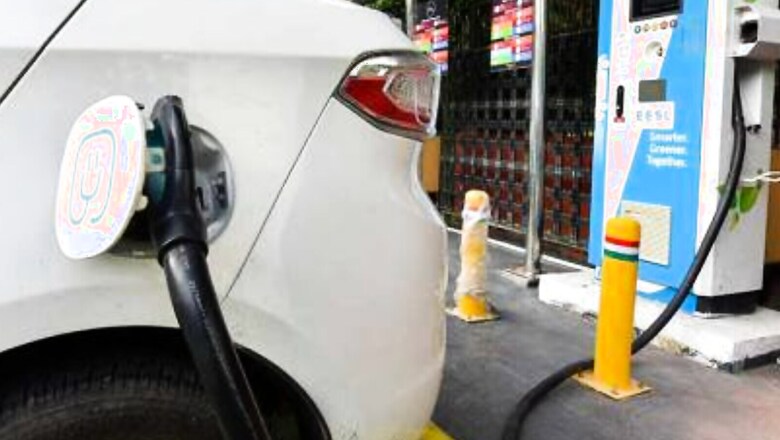
views
Electric Vehicles (EVs) are rapidly gaining popularity in India as the country looks to reduce its dependence on fossil fuels and curb air pollution. The Indian government has taken several initiatives to accelerate adoption of EV and announced several measures to strengthen the EV ecosystem, such as offering incentives to buyers, manufacturers, and creation of enabling infrastructure. However, as of 2022, the level of EV penetration in India is less than 1%. Thus, it would take significant efforts to achieve the stated government target of 30% sales of electric vehicles by 2030. To achieve this target the challenges faced by EV need to be addressed through the advancement of EV technology and conducive environment to promote innovation in the EV ecosystem.
The widespread adoption of EVs in India is hindered by several challenges, chief among them being range / distance-related concerns and charging time. To mitigate these concerns, advancements in battery technology, including increased energy density and reduced weight and charging time of batteries are necessary. As EV usage increases, so too does the demand for electricity.
Currently, only 40% of India’s electricity is generated from renewable sources. To ensure sustainable electric mobility, a greater reliance on renewable energy is required. However, this also presents challenges such as fluctuations in energy generation. To overcome this, innovations in renewable energy and local EV manufacturing are crucial to lower costs and reduce dependency on imports. Furthermore, the availability of a skilled workforce and sufficient charging infrastructure in India must be addressed.
Innovation is the Key to the Success of EV Adoption
Under the circumstances of technological nascency, innovation is the key to the success of EVs, as it enables the evolution of this transformative mode of transportation. Various aspects of innovation include improving battery technology that help in increasing EV range, energy density, and reducing the weight of the battery. Availability and access to a network of charging infrastructure can be made more efficient by use of technology such as Internet of Things (IoT), telematics, payment gateway, etc. as part of an open platform which is yet to become a reality in India. The integration of advanced technologies, such as IoT, advanced battery management systems, and renewable energy integration, are instrumental in driving the adaptation of EVs, and fostering their seamless integration into the existing transportation infrastructure.
Key expectations from the upcoming budget
In conclusion, the forthcoming budget should prioritize investments and R&D for advancements in battery technologies that augment energy density, accelerate charging, and prolong the lifespan of batteries, along with the implementation of charging infrastructure utilizing technologies such as pantograph to promote ease of access. The future of the electric vehicle industry must be facilitated through financial incentives and budget allocation for research and development of futuristic technologies. The establishment of academic and collaborative centers that foster the formation of a supportive eco-system, as well as cultivate a culture of electric vehicle innovation in academia and research, is also crucial.
The proliferation of EVs in India is rapidly increasing as the nation endeavors to ameliorate its reliance on fossil fuels and mitigate air pollution. With the right approach and investments in innovation, India can achieve its stated objectives by 2030 and contribute to a more sustainable and efficient future. Some of the specific initiatives which can be supported by the budget are as follows:
Incentivise Investment in R&D: Government can provide tax incentive on amount of investment made to bring technological innovation in EVs. Additionally, the government can invest in R&D through grants or funding to encourage collaboration between original equipment manufacturers, academic institutions and start-ups for research programs focused on EVs.
Creation of Center of Excellence/ Living Labs for Innovation: Government can allocate budget for the establishment of dedicated institutions to fostering innovation in EV. This can be in the form of Center of Excellence or Living Labs that promotes co-creation and national community-building in the realm of EVs.
Common Facilities Center for Manufacturers: The government could create a testing, research, and development center akin to Common Facilities Center, strategically located across automotive clusters. This shall support the MSMEs to avail facilities for experimenting with electric vehicle technologies to bring innovation.
Incentive to be Linked with Degree of Innovation: The quantum of incentive should be linked with the degree of innovation to encourage EV ecosystem actors to promote innovation to avail maximum incentives.
Bring EV under Priority Sector Lending: To enhance access to financing, EV financing can be categorized under Priority Sector Lending. This will help in bridging the financing gaps and further boost EV adoption.
The article is written by Sumit Mishra-Executive Director, Sahil Bhandare-Consultant, Deloitte India




















Comments
0 comment